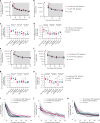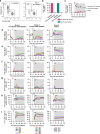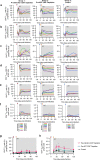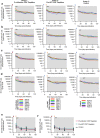CD8+ lymphocytes do not impact SIV reservoir establishment under ART
- PMID: 36690860
- PMCID: PMC9894752
- DOI: 10.1038/s41564-022-01311-9
CD8+ lymphocytes do not impact SIV reservoir establishment under ART
Abstract
Persistence of the human immunodeficiency virus type-1 (HIV-1) latent reservoir in infected individuals remains a problem despite fully suppressive antiretroviral therapy (ART). While reservoir formation begins during acute infection, the mechanisms responsible for its establishment remain unclear. CD8+ T cells are important during the initial control of viral replication. Here we examined the effect of CD8+ T cells on formation of the latent reservoir in simian immunodeficiency virus (SIV)-infected macaques by performing experimental CD8+ depletion either before infection or before early (that is, day 14 post-infection) ART initiation. We found that CD8+ depletion resulted in slower decline of viremia, indicating that CD8+ lymphocytes reduce the average lifespan of productively infected cells during acute infection and early ART, presumably through SIV-specific cytotoxic T lymphocyte (CTL) activity. However, CD8+ depletion did not change the frequency of infected CD4+ T cells in the blood or lymph node as measured by the total cell-associated viral DNA or intact provirus DNA assay. In addition, the size of the persistent reservoir remained the same when measuring the kinetics of virus rebound after ART interruption. These data indicate that during early SIV infection, the viral reservoir that persists under ART is established largely independent of CTL control.
© 2023. The Author(s).
Conflict of interest statement
The authors declare no competing interests.
Figures












Comment in
-
CD8+ T cell depletion does not induce an expansion of viral reservoir in HIV model.Nat Microbiol. 2023 Feb;8(2):191-192. doi: 10.1038/s41564-023-01321-1. Nat Microbiol. 2023. PMID: 36690862 No abstract available.
Similar articles
-
Brain Macrophages in Simian Immunodeficiency Virus-Infected, Antiretroviral-Suppressed Macaques: a Functional Latent Reservoir.mBio. 2017 Aug 15;8(4):e01186-17. doi: 10.1128/mBio.01186-17. mBio. 2017. PMID: 28811349 Free PMC article.
-
Antibody-Mediated CD4 Depletion Induces Homeostatic CD4+ T Cell Proliferation without Detectable Virus Reactivation in Antiretroviral Therapy-Treated Simian Immunodeficiency Virus-Infected Macaques.J Virol. 2018 Oct 29;92(22):e01235-18. doi: 10.1128/JVI.01235-18. Print 2018 Nov 15. J Virol. 2018. PMID: 30185596 Free PMC article.
-
Early Antiretroviral Therapy Prevents Viral Infection of Monocytes and Inflammation in Simian Immunodeficiency Virus-Infected Rhesus Macaques.J Virol. 2020 Oct 27;94(22):e01478-20. doi: 10.1128/JVI.01478-20. Print 2020 Oct 27. J Virol. 2020. PMID: 32907978 Free PMC article.
-
Brain macrophages harbor latent, infectious simian immunodeficiency virus.AIDS. 2019 Dec 1;33 Suppl 2(Suppl 2):S181-S188. doi: 10.1097/QAD.0000000000002269. AIDS. 2019. PMID: 31789817 Free PMC article. Review.
-
Mechanisms of CD8+ T cell-mediated suppression of HIV/SIV replication.Eur J Immunol. 2018 Jun;48(6):898-914. doi: 10.1002/eji.201747172. Epub 2018 Mar 26. Eur J Immunol. 2018. PMID: 29427516 Free PMC article. Review.
Cited by
-
Lymphoid tissues contribute to plasma viral clonotypes early after antiretroviral therapy interruption in SIV-infected rhesus macaques.Sci Transl Med. 2023 Dec 13;15(726):eadi9867. doi: 10.1126/scitranslmed.adi9867. Epub 2023 Dec 13. Sci Transl Med. 2023. PMID: 38091409 Free PMC article.
-
Higher HIV-1 Env gp120-Specific Antibody-Dependent Cellular Cytotoxicity (ADCC) Activity Is Associated with Lower Levels of Defective HIV-1 Provirus.Viruses. 2023 Oct 6;15(10):2055. doi: 10.3390/v15102055. Viruses. 2023. PMID: 37896832 Free PMC article.
-
Immune targeting of HIV-1 reservoir cells: a path to elimination strategies and cure.Nat Rev Microbiol. 2024 Jun;22(6):328-344. doi: 10.1038/s41579-024-01010-8. Epub 2024 Feb 9. Nat Rev Microbiol. 2024. PMID: 38337034 Free PMC article. Review.
-
The HIV-2 proviral landscape is dominated by defective proviruses.AIDS. 2024 Mar 1;38(3):309-316. doi: 10.1097/QAD.0000000000003776. Epub 2023 Nov 22. AIDS. 2024. PMID: 37916471 Free PMC article.
-
CD8+ cells and small viral reservoirs facilitate post-ART control of SIV replication in M3+ Mauritian cynomolgus macaques initiated on ART two weeks post-infection.PLoS Pathog. 2023 Sep 25;19(9):e1011676. doi: 10.1371/journal.ppat.1011676. eCollection 2023 Sep. PLoS Pathog. 2023. PMID: 37747933 Free PMC article.
References
Publication types
MeSH terms
Substances
Grants and funding
LinkOut - more resources
Full Text Sources
Medical
Research Materials

